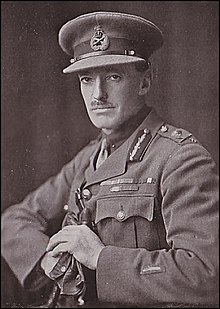| Sir Gerald Boyd | |
|---|---|
 | |
| Born | (1877-11-19)19 November 1877 London, England |
| Died | 12 April 1930(1930-04-12) (aged 52) London, England |
| Buried | Putney Vale Cemetery, London |
| Allegiance | United Kingdom |
| Service | British Army |
| Years of service | 1895–1930 |
| Rank | Major-General |
| Unit | Devonshire Regiment East Yorkshire Regiment |
| Commands | Staff College, Quetta Dublin District 46th (North Midland) Division 170th (2/1st North Lancashire) Brigade |
| Battles / wars | Second Boer War First World War |
| Awards | Knight Commander of the Order of the Bath Companion of the Order of St Michael and St George Distinguished Service Order Distinguished Conduct Medal Mentioned in Despatches |
Major-General Sir Gerald Farrell Boyd, KCB, CMG, DSO, DCM (19 November 1877 – 12 April 1930) was a senior British Army officer who served as Military Secretary from 1927 to 1930.
Military career
Educated at St Paul's School, Boyd enlisted into the Devonshire Regiment in 1895. He fought in the Second Boer War of 1899–1902, and took part in the Relief of Ladysmith, including the actions at Colenso; and in the operations in Orange River Colony, including the action at Wittebergen. During the war, he was commissioned into the 2nd Battalion, East Yorkshire Regiment in May 1900, and promoted to lieutenant in that regiment on 26 April 1902. He was mentioned in despatches three times (including 25 April 1902), received the Queen's South Africa Medal, and was appointed a Companion of the Distinguished Service Order (DSO) for his war service. The battalion stayed in South Africa throughout the war, and he returned home on the SS Orotava in December 1902, when they were stationed at Aldershot. He went on to be Brigade Major for 11th Infantry Brigade in September 1912.
Boyd served in the First World War with the 11th Infantry Brigade as part of the British Expeditionary Force. He became a General Staff Officer with 1st Division and with the 6th Division before becoming a Brigadier-General on the General Staff of 5th Army Corps in France in 1916. He was made commander of the 170th Infantry Brigade in France in July 1918 and, after being promoted to the temporary rank of major general in September, was made general officer commanding (GOC) of the 46th (North Midland) Division. He led the 46th Division when it successfully stormed the Hindenburg Line at Bellenglise during the Battle of St Quentin Canal.
After the war Boyd was made a Brigadier General on the General Staff at General Headquarters of British Army on the Rhine and then General Officer Commanding Dublin District in Ireland in 1920. He was appointed commandant of the Staff College, Quetta, in 1923 and Military Secretary in 1927. He died of cerebral spinal fever in 1930.
Family
In 1913 Boyd married Grace Sophia Burdett and they went on to have two sons.
References
- ^ "Boyd, Sir Gerald Farrell". Oxford Dictionary of National Biography. Retrieved 13 June 2020.
- ^ "Boyd, Sir Gerald Farrell". Liddell Hart Centre for Military Archives. Archived from the original on 25 September 2012. Retrieved 13 June 2020.
- "No. 27474". The London Gazette. 16 September 1902. p. 5962.
- "No. 27428". The London Gazette. 25 April 1902. p. 2766.
- "No. 27490". The London Gazette. 31 October 1902. p. 6901.
- "The Army in South Africa – Troops returning home". The Times. No. 36957. London. 22 December 1902. p. 10.
- "No. 28649". The London Gazette. 1 October 1912. p. 7193.
- "No. 30949". The London Gazette (Supplement). 11 October 1918. p. 12042.
Further reading
- Priestley, R. E. (1919). Breaking the Hindenburg Line. London: T. Fisher Unwin, Ltd.
| Military offices | ||
|---|---|---|
| Preceded byWilliam Thwaites | GOC 46th (North Midland) Division 1918–1919 |
Succeeded bySir Reginald Hoskins |
| Preceded byL. R. Vaughan | Commandant of the Staff College, Quetta 1923–1927 |
Succeeded byC. A. C. Goodwin |
| Honorary titles | ||
| Preceded byFrancis Seymour Inglefield | Colonel of the East Yorkshire Regiment 1925–1930 |
Succeeded byHenry Haggard |
| Military offices | ||
| Preceded bySir David Campbell | Military Secretary 1927–1930 |
Succeeded bySir Sidney Clive |
- 1877 births
- 1930 deaths
- People educated at St Paul's School, London
- British Army major generals
- Devonshire Regiment soldiers
- East Yorkshire Regiment officers
- Knights Commander of the Order of the Bath
- Companions of the Order of St Michael and St George
- Companions of the Distinguished Service Order
- Recipients of the Distinguished Conduct Medal
- Commandants of the Staff College, Quetta
- Military personnel from London
- British Army generals of World War I
- British Army personnel of the Second Boer War